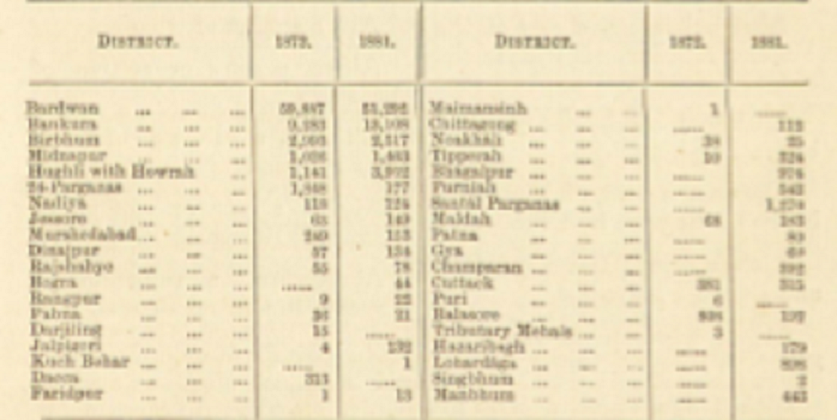Aguri
Additional information may please be sent as messages to the Facebook community, Indpaedia.com. All information used will be gratefully acknowledged in your name. *
Contents |
Aguri
Internal Structure
This section is an extract from
THE TRIBES and CASTES of BENGAL. Ethnographic Glossary. Printed at the Bengal Secretariat Press. 1891. . |
NOTE 1: Indpaedia neither agrees nor disagrees with the contents of this article. Readers who wish to add fresh information can create a Part II of this article. The general rule is that if we have nothing nice to say about communities other than our own it is best to say nothing at all.
NOTE 2: While reading please keep in mind that all articles in this series have been scanned from a very old book. Therefore, footnotes have got inserted into the main text of the article, interrupting the flow. Readers who spot scanning errors are requested to report the correct spelling to the Facebook page, Indpaedia.com. All information used will be duly acknowledged.
A cultivating and trading caste, very numerous in Western Bengal. They are popularly believed to be the modern representatives of the Ugra or Ugra Kshatriyas mentioned in Manu, x, 9: "From a Kshatriya by a Sudra girl is born a creature called an Ugra (cruel), which has a nature partaking both of Kshatriya and of Sudra, and finds its pleasure in savage conduct." In verse 49 of the same chapter their occupation is said to be "catching and killing animals that live in holes." At the present day the Aguris are divided into seven sub-castes, viz. (1) Bard¬waniya, (2) Kasipuriya, (3) Bagha, (4) Satchaki or Satsaikiya, (5) Chagnaya or Changa, (6) Jana, (7) Suta.
Each of these is subdivided into Rulins [Kulins?] and Mauliks, the former being distinguished by the titles Resh, Pai, Shyam, and Pal A Kulin is not positively forbidden to marry a Maulik, but to do so brings a certain amount of discredit on the Kulin bridegroom, and a series of such marriage would reduce the entire family to the rank of Maulik. Intermarriage between members of different sub-castes is prohibited, and the Hna [please correct if wrong] and Suta sub-castes, both of whom profess to be descended from a mythical ancestor named Dakshin Rai, taunt one another with being bastards. The entire caste claims to be twice-born (dwija), but the sacred thread is worn only by members of the Jana sub-caste, who assume it on marriage. Those, however, who work as cultivators and drive the plough with their own hands usually discard the thread.
Each sub-caste contains a number of sections, bearing names-Kasyap, Sandilya and Bharadwaja and others-which appear to show that they have been borrowed from the Brahmans. Marriage is forbidden within the section, and the supplementary rules defining the prohibited degrees are substantially the same as among Brahmans and Kayasths. Aguris marry their daughters as infants, forbid widows to marry again, and do not recognise divorce. A woman of proved unchastity is turned out of the caste, and usually takes refnge among the Bairagi Vaishnavas or some similar religious sect: . Polygamy is permitted, but IS not practised on a large scale, and It IS rare to find men with more than two wives.
Religion
In their religious and ceremonial observances Aguris differ little from the higher castes of Hindus in Bengal.
They belong for the most part to the Vaishnava and Sakta sects, and there are comparatively few Saivas among them. Their religious ceremonies are performed by Brahmans, who incur no degradation by serving them. It deserves notice that the first 81'ciddh [?] is performed by them on the thirtieth day after death, and not, as is the case with Brahmans, on the eleventh day.
Social status
The following table shows the distribution of Aguris in Bengal in 1872 and 1881 :¬
The social position of the Aguris differs in different parts of Bengal. The scattered members of the caste found in Eastern Bengal are classed with the hunting and fishing castes-a fact which suggests that there may be an element of historical truth in the functions assigned to them by Manu. In Bardwan and Western Bengal, where Aguris are numerous, they take rank with the Nava-Sakha, and Brahmans will take water and certain kinds of sweetmeats from their hands. Many of them hold estates and tenures of various grades, and the bulk of the caste are fairly prosperous cultivators. If popular rumour may be trusted, they still, as in the days of Manu, "find pleasure in savage conduct," for they are said to be extraordinarily short-tempered and irascible, and the criminal records of the districts where they are most numerous seem to show that, in proportion to the numbers of the caste, an unusual number of crimes of violence were laid to their charge.
Aguri
(From People of India/ National Series Volume VIII. Readers who wish to share additional information/ photographs may please send them as messages to the Facebook community, Indpaedia.com. All information used will be gratefully acknowledged in your name.)
Synonyms: Ugra Khatriya [Bihar and/or Jharkhand]
Ugra Khsatriya [West Bengal]
Groups/subgroups: Bagha, Jana, Jorburi, Suta [Bihar and/or Jharkhand]
Jana or Janau, Sut [West Bengal]
- Subcastes: Bagha, Bardwaniya, Chagnaya or Changa, Jana, Kasipuriya, Satchad, Suta [H.H. Risley]
Appendix B I057
Titles: Chowdhari, Khan, Mandal, Roy [West Bengal]
Kesh, Pai, Pal, Shyam [H.H. Risley]
Surnames: Duna, Gain, Had, Hazra, Jana, Jash, Kesh, Panja, Sain, Samanta, Santra, Shyam, Som [Bihar and/or Jharkhand]
Chowdhuri, Dikpati, Hazra, Josh, Khan, Konar, Kundu, Mandal, Nandi, Nayak, Roy, Rudra, Sarkar [West Bengal]
Exogamous units/clans: Batsaba, Bidvangshu, Katyayana, Shankarsanrishi [West Bengal]
Gotra: Bharadwaj, Kashyap, Parasar, Sandilya, Vasishta [Bihar and/or Jharkhand]
Batsaba, Bharadwaj, Goutam, Kashyap, Katyayana [West Bengal]
Bharadwaja, Kashyap, Sandilya [H.H. Risley]
Exogamous units/lineages (ekbibha): [West Bengal]
